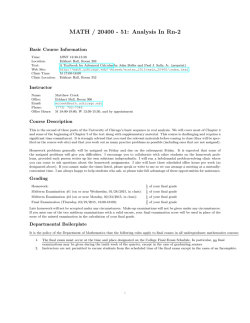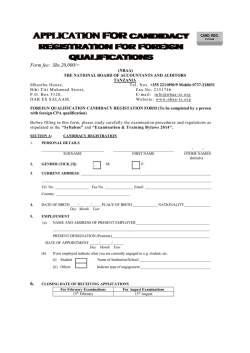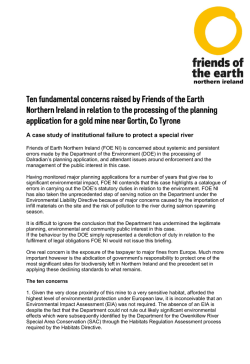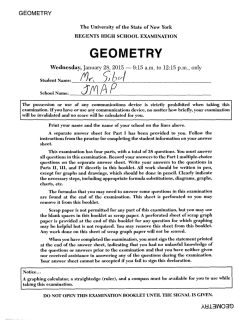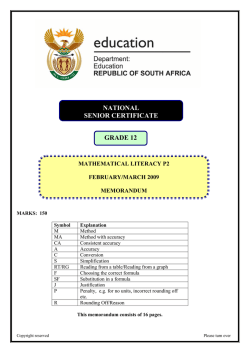
documento 457418
SENIOR CERTIFICATE EXAMINATION – 2008 PHYSICAL SCIENCE P1 PHYSICS HIGHER GRADE MAY/JUNE 2008 MARKS: 200 TIME: 2 hours This question paper consists of 17 pages, 2 data sheets, 1 multiple-choice answer sheet and 1 sheet graph paper. NOTE: QUESTION 9.1 MUST BE ANSWERED ON THE GRAPH PAPER PROVIDED. Copyright reserved Please turn over Physical Science/HG/P1 2 Senior Certificate Examination DoE/May-Jun./2008 GENERAL INSTRUCTIONS 1. Write your examination number (and centre number if applicable) in the appropriate spaces on the ANSWER BOOK. 2. Answer ALL the questions. 3. Non-programmable calculators may be used. 4. Appropriate mathematical instruments may be used. 5. Data sheets have been attached for your use. 6. NOTE: The following circuit diagram symbols are used in this paper: 7. Resistor: instead of /\/\/\/\/ Bulb: instead of /\/\/\/\/ Marks may be forfeited if instructions are not followed. QUESTION 1 INSTRUCTIONS 1. Answer this question on the specially printed ANSWER SHEET. [NOTE: The answer sheet may either be a separate sheet provided as part of your question paper, or printed as part of the ANSWER BOOK.] Write your EXAMINATION NUMBER (and centre number if applicable) in the appropriate spaces, if a separate answer sheet is used. 2. Four possible answers, indicated by A, B, C and D, are supplied with each question. Each question has only ONE correct answer. Choose only that answer which in your opinion is the correct or best one and mark the appropriate block on the ANSWER SHEET with a cross (X). 3. Do NOT make any other marks on the answer sheet. Any calculations or writing that may be necessary when answering this question should be done in the ANSWER BOOK and must be clearly deleted by means of a diagonal line drawn across the page. 4. If more than one block is marked, NO marks will be awarded for that answer. PLACE THE COMPLETED ANSWER SHEET INSIDE THE FRONT COVER OF YOUR ANSWER BOOK, IF A SEPARATE ANSWER SHEET HAS BEEN USED. EXAMPLE QUESTION: The SI unit of time is ... A B C D ANSWER: t. h. s. m. A B C D [NOTE: This layout may vary, depending on the type of answer sheet used by the province.] Copyright reserved Please turn over Physical Science/HG/P1 3 Senior Certificate Examination DoE/May-Jun./2008 QUESTION 1 1.1 1.2 Which ONE of the following physical quantities has the same unit as the product of the force and the displacement in the direction of the force? A Power B Energy C Acceleration D Momentum (4) The diagram below shows an object of mass m, suspended by a string. A horizontal force F is applied to the object and keeps the string at an angle of θ with the vertical. The force exerted by the string on the object is T. θ T m F Which ONE of the following relationships is correct when the object is in equilibrium? 1.3 A T cos θ + F = 0 B T cos θ - mg = 0 C T cos θ - F = 0 D T sin θ - mg = 0 (4) One of the equations of motion is v2 = u2 + 2as. What is the unit of the physical quantity represented by the term 2as? A m.s-1 B m.s-2 C m2.s-1 D m2.s-2 Copyright reserved (4) Please turn over Physical Science/HG/P1 DoE/May-Jun./2008 The following displacement-time graph represents the motion of an object. Displacement (m) 1.4 4 Senior Certificate Examination M K N O P Time (s) Which ONE of the following relationships between the intervals on the above graph can be used to determine the average velocity of the object? 1.5 A MN KN B MP OP C 1 (MP + KO)(OP) 2 D 1 (KN) (MN) 2 (4) Jake suspends two identical parcels from rope E attached to the ceiling and rope F attached between the parcels, as indicated in the diagram below. E F Which ONE of the following relationships between the tension, TE, in rope E, and the tension, TF, in rope F is correct? A TE > TF B TE < TF C TE = TF ≠ 0 N D TE = TF = 0 N Copyright reserved (4) Please turn over Physical Science/HG/P1 DoE/May-Jun./2008 The following velocity-time graph represents the motion of a car along a straight horizontal track for the time period indicated. Velocity (m.s-1) 1.6 5 Senior Certificate Examination 0 t1 Time (s) t2 Which ONE of the following is the correct distance-time graph for the motion of the car? Distance (m) 0 Distance (m) t1 t2 Time (s) 0 A t2 Time (s) t2 Time (s) B Distance (m) 0 t1 Distance (m) t1 C t2 Time (s) 0 t1 D (4) Copyright reserved Please turn over Physical Science/HG/P1 1.7 6 Senior Certificate Examination DoE/May-Jun./2008 A block of mass m rests on a rough, horizontal surface. When a force F is applied to the block at an angle θ to the horizontal, it moves with constant acceleration. F θ m From this it can be concluded that the magnitude of the frictional force acting on the block, is … 1.8 A equal to F. B equal to F cos θ . C greater than zero, but smaller than F cos θ . D greater than F cos θ , but smaller than F. (4) Which ONE of the following statements concerning the inertia of an object is true? A Only objects which are in equilibrium will have inertia. B Inertia is that force which causes a body to remain at rest or in uniform motion in a straight line. C Inertia is that force which causes a body to accelerate uniformly along a straight line. D Inertia is that property of an object with mass which causes it to remain at rest or in uniform motion in a straight line. Copyright reserved (4) Please turn over Physical Science/HG/P1 1.9 7 Senior Certificate Examination DoE/May-Jun./2008 Three identical billiard balls, P, M and N, are on a frictionless horizontal surface. P moves to the right with a speed of 3v and collides with M and N, which are initially at rest and in contact with each other. Momentum and kinetic energy are conserved during the collision. P 3v M N What is the speed of the balls P, M and N after the collision? 1.10 Speed of P Speed of M Speed of N A 0 0 3v B 0 v 2v C v v v D 2v 0,5v 0,5v (4) Trolley P of mass m, and another trolley Q of mass 2m, are released from rest from the same vertical height h and run down two tracks. Trolleys P and Q travel distances x and 2x respectively by the time they reach the bottom of their respective tracks. Disregard all frictional forces. P m x h Q 2m 2x If P has kinetic energy of Ek at the bottom of its track, what is the kinetic energy of Q at the bottom of its track? A 4Ek B 2Ek C D Copyright reserved 2 Ek Ek (4) Please turn over Physical Science/HG/P1 1.11 8 Senior Certificate Examination DoE/May-Jun./2008 A negative point charge, q, is stationary between two oppositely charged, parallel plates, which are a distance d from each other (FIGURE 1). The point charge experiences an electric force F due to the electric field E between the parallel plates. + + + q - - + + d - + 3d FIGURE 1 + - - q - + - FIGURE 2 The distance between the plates is increased to 3d, while the potential difference across the plates remains the same (FIGURE 2). Which ONE of the following statements regarding the motion of the point charge in FIGURE 2 is correct? 1.12 A The charge moves upward at constant velocity. B The charge moves downward at constant velocity. C The charge accelerates uniformly downwards. D The charge accelerates uniformly upwards. (4) An alpha (α) particle (an He atom without its electrons) is held stationary at a distance r from a fixed, negatively charged sphere, as indicated in the diagram below. The electric field strength at that point where the particle is located is E, and the electrical potential energy relative to the sphere is EP. Sphere α-particle ----- r If the particle is released, it moves towards the sphere. Which ONE of the following combinations is correct for the new values of E and EP when the particle is a distance 1 r from the sphere? 2 Electric field strength E Potential energy EP A 1E 4 Increases B 1E 4 Decreases C 4E Increases D 4E Decreases Copyright reserved (4) Please turn over Physical Science/HG/P1 1.13 9 Senior Certificate Examination DoE/May-Jun./2008 Three identical conducting wires, P, Q and R, carry currents in the directions as indicated. The wires are placed equal distances apart on the same horizontal, frictionless, insulated surface with Q and R fixed to the surface, while P is free to move. Q P R Which ONE of the following statements concerning P is correct? P will … 1.14 A remain stationary. B accelerate towards Q. C accelerate towards R. D move at a constant velocity towards Q. (4) A battery, with emf E and considerable internal resistance, is connected to a resistor R and switch S, as shown in the diagram below. The resistance of the connecting wires is negligible. Voltmeter V has a very high resistance. • • S E R V Which ONE of the following combinations is correct regarding the reading on voltmeter V? Reading on voltmeter V when switch S is open Reading on voltmeter V when switch S is closed A 0 E B 0 Less than E C E E D E Less than E Copyright reserved (4) Please turn over Physical Science/HG/P1 1.15 10 Senior Certificate Examination DoE/May-Jun./2008 The cell in the circuit represented below has negligible internal resistance. Resistors R1 and R2 are connected in parallel and switch S is closed. V R1 S • • R3 R2 A What happens to the voltmeter and ammeter readings when switch S is opened? Voltmeter reading V Ammeter reading A A Decreases Decreases B Increases Increases C Remains the same Increases D Remains the same Decreases (15 x 4) Copyright reserved (4) [60] Please turn over Physical Science/HG/P1 11 Senior Certificate Examination DoE/May-Jun./2008 ANSWER QUESTIONS 2 TO 10 IN THE ANSWER BOOK. INSTRUCTIONS 1. Start each question on a NEW PAGE in the ANSWER BOOK. 2. Leave a line between subsections, for example QUESTION 2.1 and QUESTION 2.2. 3. Show ALL formulae, as well as the calculations, including substitutions. 4. Number the answers exactly as the questions are numbered. QUESTION 2 [START ON A NEW PAGE.] In a game park, animals are captured and transported in crates that need to be pulled onto trucks using an inclined plane. During one of these exercises, a rhinoceros in a crate is held at rest by means of a cable along an incline, which makes an angle of 20° with the horizontal. The tension in the cable is 2 500 N as indicated in the diagram below and the inclined plane can be regarded as frictionless. 2 500 N rhino 20° 2.1 State, in words, the triangle rule of forces in equilibrium. (3) Consider the equilibrium of the crate containing the rhino. 2.2 2.3 Draw a labelled triangle of forces acting on the crate and indicate at least TWO appropriate angles. Use your force diagram to calculate the combined mass of the rhino and the crate. Copyright reserved (5) (5) [13] Please turn over Physical Science/HG/P1 12 Senior Certificate Examination QUESTION 3 DoE/May-Jun./2008 [START ON A NEW PAGE.] A hot-air balloon ride is a favourite item at a holiday resort. The velocity-time graph below represents the motion of the balloon starting from the ground with an initial speed of 5 m.s-1 during one of the rides. The balloon moves vertically upwards for some time and then it starts moving downwards. Take upwards as positive. 8 Velocity -1 (m.s ) 6 P• •Q 4 2 T R 0 200 400 • 600 800 1 000 • 1 200 U 1 400 • 1 600 Time (s) -2 -4 • S -6 3.1 Use the graph to find the maximum height reached by the balloon. (4) 3.2 Calculate the average speed during the upward journey. (4) 3.3 Briefly describe, in terms of velocity, the motion of the balloon during interval RS. (2) 3.4 Calculate the magnitude of the acceleration of the balloon during interval QR. (4) 3.5 Without calculation, state the speed of the balloon at point T. (1) 3.6 Calculate the height of the balloon above the ground, when it is at point T. (5) 3.7 Draw a sketch graph of displacement versus time for the motion of the balloon from R to U (t = 500 s to t = 1 600 s). No numerical values need to be indicated. Copyright reserved (3) [23] Please turn over Physical Science/HG/P1 13 Senior Certificate Examination QUESTION 4 DoE/May-Jun./2008 [START ON A NEW PAGE.] A steel ball is dropped from rest at point A above a window. The ball takes 0,25 s to travel from B to C, which is a window of length (height) 1,5 m. Ignore the effects of air resistance. A B 1,5 m C 4.1 Define, in words, the term displacement. (2) 4.2 Show, by calculation, that the velocity of the ball at B is equal to 4,75 m.s-1. (5) 4.3 Use relevant equations of motion to calculate the height (sAB) above the top of the window, from where the steel ball was dropped. QUESTION 5 (5) [12] [START ON A NEW PAGE.] Two blocks, X and Y, each of mass 2 kg, are connected by an inelastic rope of negligible mass. When a constant force of 6 N is applied horizontally to the right on block Y, the blocks accelerate at 0,5 m.s-2. The frictional force between the blocks and the surface is the same. a = 0,5 m.s-2 X Y 2 kg 2 kg Fapplied = 6 N 5.1 State, in words, Newton's Second Law of Motion. (3) 5.2 Draw TWO separate force diagrams, with labels, showing the horizontal forces acting on X and Y. (4) 5.3 Calculate the magnitude of the frictional force experienced by block X AND the magnitude of the tension in the string that connects X and Y. Copyright reserved (9) [16] Please turn over Physical Science/HG/P1 QUESTION 6 14 Senior Certificate Examination DoE/May-Jun./2008 [START ON A NEW PAGE.] Meteorite Hoba, in Namibia, is the biggest known meteorite on earth. It has a mass of approximately 70 000 kg. More or less 80 000 years ago, on its way to earth, its centre was a distance r away from the centre of the earth. The gravitational force exerted by the earth of mass 6 x 1024 kg on the meteorite was equal to 2,75 x 104 N. Hoba Earth r 6.1 Calculate the distance r from the centre of the earth at that stage. (5) 6.2 As Hoba was coming closer to the earth the magnitude of the force exerted by the earth on it changed. Was the force increasing, decreasing or remaining the same? Explain your answer, naming a relevant law of physics. (4) [9] QUESTION 7 [START ON A NEW PAGE.] Percy, of mass 75 kg, rides a quad bike (motorcycle with 4 wheels) with a mass of 100 kg, at a speed of 20 m.s-1. As he approaches a red traffic light on a wet and slippery road, Percy suddenly applies the brakes. The wheels of the quad bike lock and it skids (slides) in a straight line. The force of friction due to the road causes the bike to change its velocity from 20 m.s-1 to 0 m.s-1 in 8 s. 7.1 State, in words, the Principle of Conservation of Momentum. (3) 7.2 Percy states that the reason why he kept moving forward was because of the conservation of momentum. Is his statement TRUE or FALSE? (1) Determine the change in momentum of Percy and the bike, from the moment the brakes lock until the bike comes to a stop. (7) Calculate the magnitude of the average frictional force exerted by the road on the wheels. (3) 7.3 7.4 7.5 Calculate the work done by the frictional force in bringing the quad bike to rest. Copyright reserved (5) [19] Please turn over Physical Science/HG/P1 QUESTION 8 15 Senior Certificate Examination DoE/May-Jun./2008 [START ON A NEW PAGE.] Two charged conducting spheres, P and Q, on insulated stands, carry charges of -8 x 10-9 C and +16 x 10-9 C respectively. The spheres are placed 20 mm from each other, as indicated in the diagram below. -8 x 10-9 C 8.1 8.2 P 20 mm Q +16 x 10-9 C Calculate the magnitude of the resultant electric field strength halfway between P and Q. (7) Calculate the magnitude of the force that a proton will experience halfway between the two charged spheres. (3) The two spheres are moved to make contact with each other, after which they are moved back to their original positions. 8.3 Determine the new charge on each sphere. (2) 8.4 How much charge was transferred? (2) 8.5 State, in words, Coulomb's Law. (4) 8.6 Without applying Coulomb's law, determine the factor by which the force that the one sphere exerted on the other changed, after the spheres made contact and were placed back in their original positions. Copyright reserved (3) [21] Please turn over Physical Science/HG/P1 QUESTION 9 16 Senior Certificate Examination DoE/May-Jun./2008 [START ON A NEW PAGE] Lindi investigates the relationship between the current and the energy transferred by a resistor X, immersed in water in an insulated calorimeter. She applies constant currents of 1 A, 2 A, 3 A and 4 A, each for a period of 5 minutes. She uses a thermometer to measure the rise in temperature corresponding to each of the applied currents. The mass of the water is kept constant throughout the experiment. The diagram below shows the set-up of the apparatus used. Variable resistor A • • Thermometer Calorimeter Resistor X The energy, W, transferred by resistor X, was calculated in each experiment assuming 100% efficiency. The values are presented in a table. Current (I) in A 1 2 3 4 9.1 9.2 9.3 Current2 (I2) in A2 1 4 9 16 Energy (W) transferred by resistor X in joules 600 2 400 5 400 9 600 Use a suitable scale to draw a graph with energy transferred on the vertical (dependent) axis and I2 on the horizontal (independent) axis on the graph paper provided. Plot the points and sketch a straight-line graph. Label your graph clearly. (6) Describe in words the relationship between I2 and the energy transferred by the resistor, as reflected by the graph. (2) Calculate the resistance of the resistor Lindi used in her investigation. Copyright reserved (5) [13] Please turn over Physical Science/HG/P1 QUESTION 10 17 Senior Certificate Examination DoE/May-Jun./2008 [START ON A NEW PAGE.] Thembi wants to listen to her radio which is rated 6 V, 3 W. The only available battery is a 24 V battery. She decides to use an appropriate resistor to get the correct voltage for her radio. 10.1 10.2 10.3 Calculate the maximum current which the radio draws from the battery when operating at its rated voltage. (4) Draw a circuit diagram to show how Thembi should connect the resistor to the radio and the battery. (3) If the battery has an internal resistance of 2 Ω, calculate the resistance of the resistor which Thembi has to use. Copyright reserved (7) [14] TOTAL QUESTION 1: 60 TOTAL QUESTIONS 2 – 10: 140 GRAND TOTAL: 200 Physical Science/HG/P1 1 Senior Certificate Examination DoE/May-Jun./2008 DEPARTMENT OF EDUCATION DEPARTEMENT VAN ONDERWYS SENIOR CERTIFICATE EXAMINATION SENIORSERTIFIKAAT-EKSAMEN DATA FOR PHYSICAL SCIENCE PAPER I (PHYSICS) GEGEWENS VIR NATUUR- EN SKEIKUNDE VRAESTEL I (FISIKA) TABLE 1: PHYSICAL CONSTANTS TABEL 1: FISIESE KONSTANTES SYMBOL/SIMBOOL NAME/NAAM Acceleration due to gravity VALUE/WAARDE g 10 m.s−2 G 6,7 × 10−11 N.m2.kg−2 e− −1,6 × 10−19 C Swaartekragversnelling Gravitational constant Swaartekragkonstante Charge on electron Lading op elektron MATHEMATICAL AIDS/WISKUNDIGE HULPMIDDELS B a c A b C sinA sinB sinC = = a b c c2 = a2 + b2 - 2ab cosC Copyright reserved Please turn over Physical Science/HG/P1 2 Senior Certificate Examination DoE/May-Jun./2008 TABLE 2: FORMULAE TABEL 2: FORMULES MOTION/BEWEGING 1 2 at 2 v = u + at s = ut + v 2 = u 2 + 2as ⎛u + v ⎞ s = ⎜ ⎟t ⎝ 2 ⎠ FORCE/KRAG p = mv Fres = ma F = Gm1m 2 FΔt = Δp = mv - mu r2 WORK, ENERGY AND POWER/ARBEID, ENERGIE EN DRYWING W = Fs P = Ep = mgh W t 1 mv 2 2 Ek = ELECTROSTATICS/ELEKTROSTATIKA F = E = E = kQ1Q 2 r2 F q kQ r 2 (k = 9 × 109 N.m2.C−2 ) V = W Q W = QEs (k = 9 × 109 N.m2.C−2 ) E = V d CURRENT ELECTRICITY/STROOMELEKTRISITEIT Q = It emf/emk = I(R + r) R = r1 + r2 + r3 + … F = 1 1 1 1 = + + + ... R r1 r2 r3 V 2t R V2 P = VI = I2 R = R R = V I Copyright reserved kI1 I2 l d W = VIt = I2Rt = (k = 2 x 10-7 N.A-2) Physical Science/HG/P1 DoE/May-Jun./2008 Senior Certificate Examination ANSWER SHEET/ANTWOORDBLAD Examination number Eksamennommer DEPARTMENT OF EDUCATION DEPARTEMENT VAN ONDERWYS PHYSICAL SCIENCE HIGHER GRADE PAPER 1 (PHYSICS) NATUUR- EN SKEIKUNDE HOËR GRAAD VRAESTEL 1 (FISIKA) 1.1 A B C D 1.2 A B C D 1.3 A B C D 1.4 A B C D 1.5 A B C D 1.6 A B C D 1.7 A B C D 1.8 A B C D 1.9 A B C D 1.10 A B C D 1.11 A B C D 1.12 A B C D 1.13 A B C D 1.14 A B C D 1.15 A B C D Copyright reserved For the use of the marker Vir die gebruik van die nasiener Marks obtained Punte behaal Marker's initials Nasiener se paraaf Marker's number Nasiener se nommer Physical Science/HG/P1 DoE/May-Jun./2008 Senior Certificate Examination Examination number Eksamennommer QUESTION 9.1/VRAAG 9.1 Hand in this graph paper with your ANSWER BOOK and ensure that your examination number is entered in the appropriate spaces at the top of this page! Copyright reserved
© Copyright 2025
